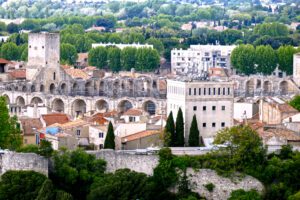Thou shalt have no other gods before me – Paris takes this commandment very seriously: Because of French centralism, hardly any other city in France has the chance to shine, let alone achieve world fame. And Aix-en-Provence is hit with a double whammy, because it is also in the immediate vicinity and therefore in the shadow of the second largest city, Marseille.
Well, this way, only the real connoisseurs will discover this gem in the heart of Provence. Everyone else misses out on the breathtaking architecture and 250 fountains, hot springs, and thermal baths as well as 300 days of sunshine a year. They won’t enjoy either the iconic bouillabaisse and ratatouille or delicious local wine.
What’s that? You don’t want to miss out on all this?
Then you’ve come to the right place: In this post, I’ll show you the best things to do in Aix-en-Provence, one of France’s most exquisite cities.
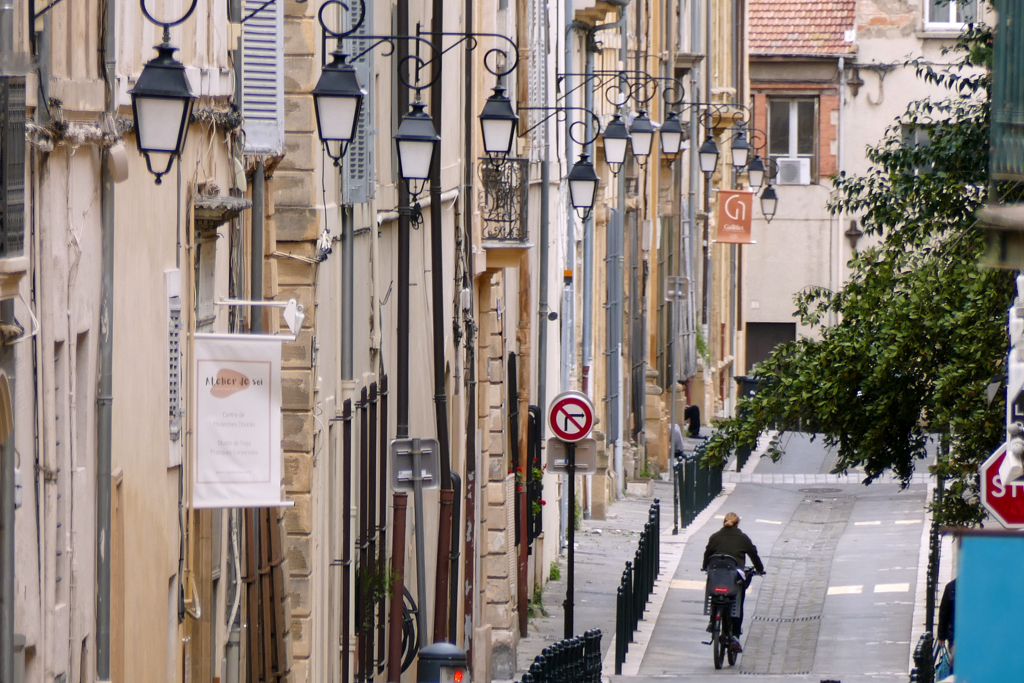
- Rel-Aix-en-Provence
- Wells, Wellness, And Wealth
- Cours Mirabeau
- Aix’s Most Distinctive Fountains
- Fontaine des Quatre Dauphins
- Fontaine de la Rotonde
- Fontaine des Neuf Canons
- Fontaine Moussue
- Fontaine Du Roi René
- Rue Fontaine d’Argent
- Fontaine de Prêcheurs
- Fontaine des Bagniers
- Fontaine des Lumières
- Fontaine Sanglier
- Fontaine de l’Hôtel de Ville
- Fontaine des Cardeurs
- Fontaine des Tanneurs
- Fontaine Séraphin Gilly
- Fontaine Des Augustins
- Fontaine Villeverte
- Fontaine des Minimes
- Aix’s Most Inviting Squares
- What Else Aix Has to Offer
- Practical Information
- Map
- Pinnable Pictures
Rel-Aix-en-Provence
Arles has the Roman amphitheater, Avignon has the former papal palace, and Marseille’s landmarks are spread over many square kilometers. Phew, as inspiring as a tour of the Provence is, at some point, it also becomes exhausting.
And then you get to Aix-en-Provence.
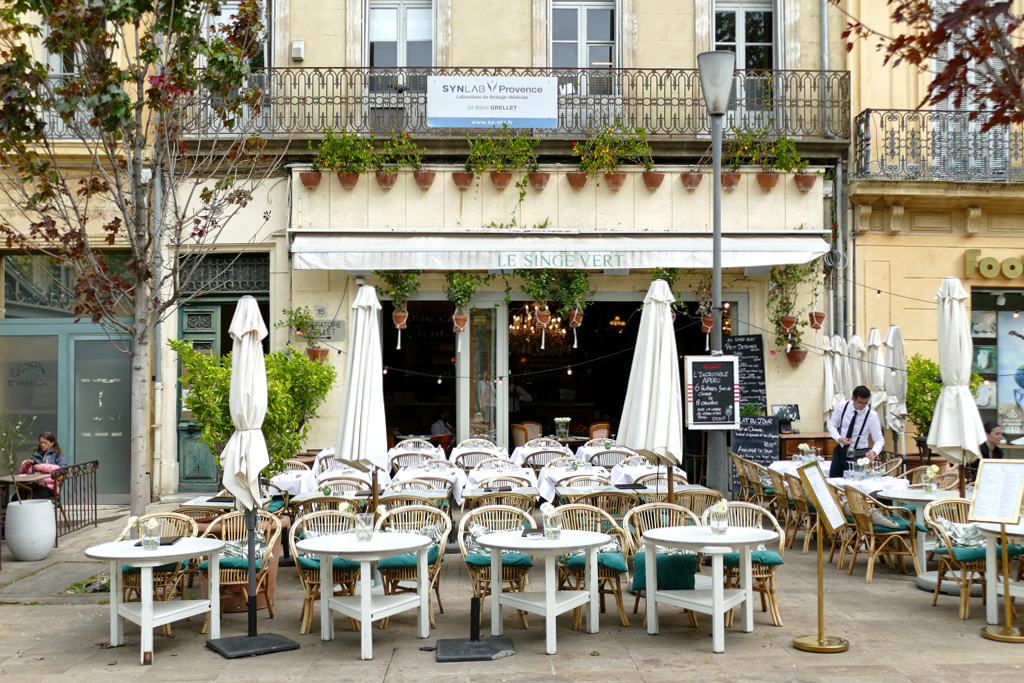
Strolling along the Cours Mirabeau just above the glorious Place de la Rotonde, you pass cafés where people on large terraces are chatting in the early morning sun or cozily reading today’s newspaper. The old-fashioned, decelerated printed version. In front of them, the waters of the quirky Fontaine Moussue are gurgling softly. Even they emit peace and comfort as they leisurely drop from the moss into the pool.
The Journey is the Reward
I turn into a side street and stroll towards Musée Granet. The door is locked. Damn, I forgot, today is Monday, hence, most museums and hairdressers of the world are traditionally closed.

At least I can enjoy the sight of the Fontaine des Quatre Dauphins down the street until a young woman sits down on the edge of the basin and lights a cigarette. This somehow bursts the bubble of serenity, and I keep meandering through the old center. The locations of the uncountable fountains miraculously seem to guide my path.
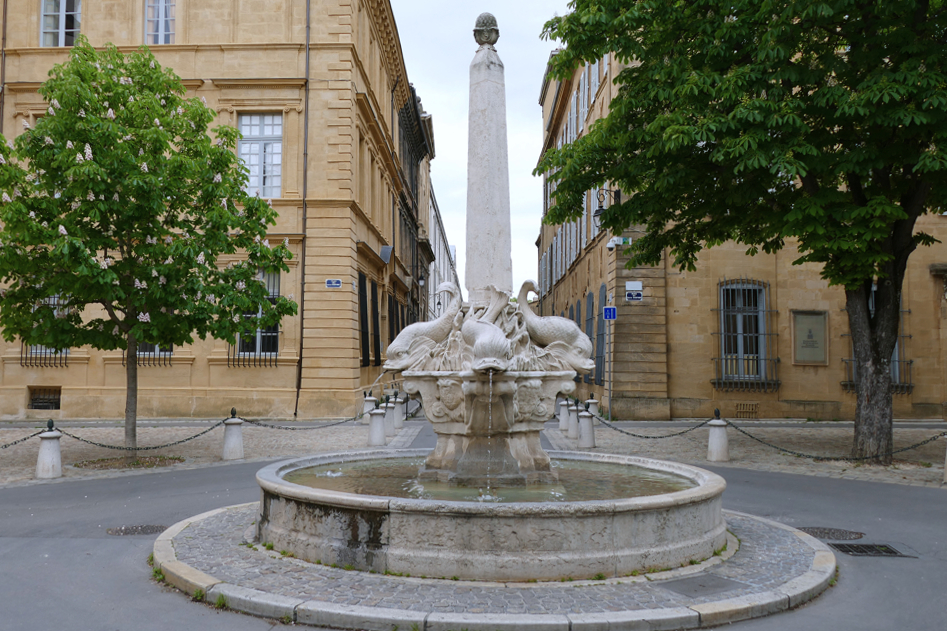
Slowly I realize that Aix-en-Provence doesn’t need an Eiffel Tower or any other imposing landmark to be a city absolutely worth visiting.
Actually, the city as such is one big landmark! A complete work of art, so to speak.
Wells, Wellness, And Wealth
Aix-en-Provence – doesn’t that just sound melodious? In fact, Aix owes its beautiful name to the thermal springs that existed as early as 123 BC when the Romans founded the city. They called it Aquae Sextiae, whereby Aquae goes back to the water of the thermal springs, obviously. Over time, it became Aix.
To this day, the city is proud of its thermal baths and uncountable fountains, but also of its more than 300 days of sunshine per year.
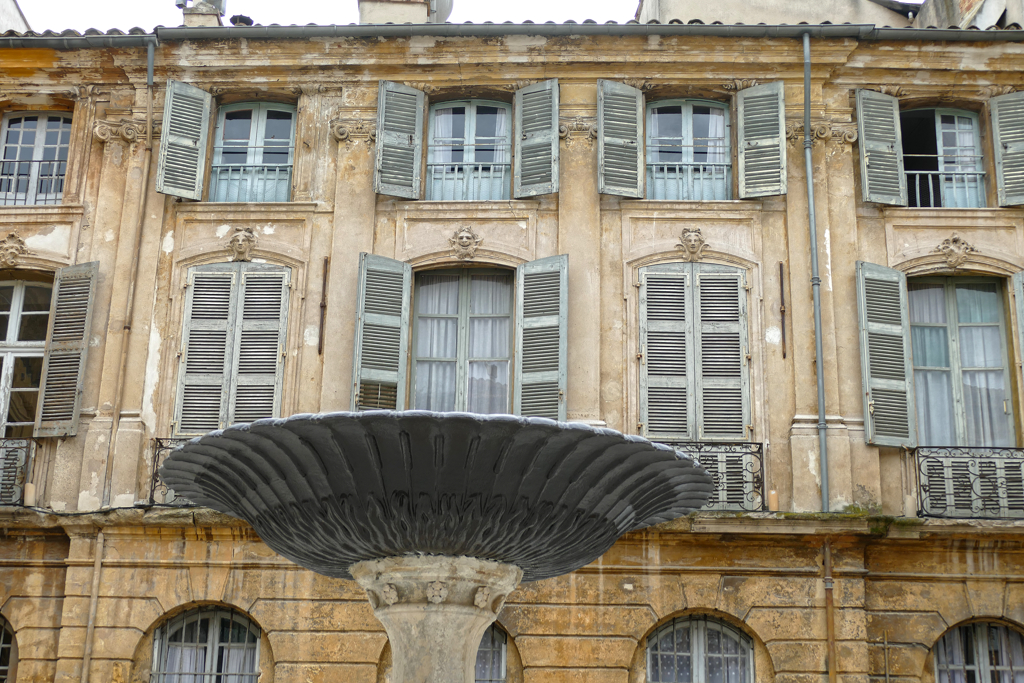
As a matter of fact, Aix-en-Provence was the capital of Provence in the 15th century. With the rise of Marseille to become the regional center and capital of the newly created department of Bouches-du-Rhône, Aix lost its political importance. The university founded by Ludwig II closed some of its faculties, and the parliament was converted into a courthouse.
And the Beat Goes On
Despite the loss of political importance, numerous noble families built their city palaces in Aix in the 17th and 18th centuries. The magnificent buildings in the Baroque style still characterize the city today.

The city also continued to attract painters and writers.
It was the birthplace of the post-impressionist artist Paul Cézanne. To this day, you can follow in his footsteps along a hiking trail and visit his childhood home, the so-called Jas de Bouffan, as well as his former studio. But the city also captivated other grandmasters of literature and art such as Paul Guigou, Émile Zola, and Marie-Henri Beyle, better known by his pseudonym Stendhal, and inspired them to create some of their most important chef-d’oeuvres.
You see, Aix doesn’t need to advertise itself blatantly. It can sit back and relax and let the illustrious past reflect on its inspiring presence and promising future.
Cours Mirabeau
The heart of Aix and the perfect starting point for exploring the city is the Place de la Rotonde. Marked by the largest of Aix’s fountains, this is where many important streets converge. Its imposing centerpiece, the Fontaine de la Rotonde, with three allegorical statues for art, agriculture, and justice towering over the basin, was built in 1860.

As you turn to the west, the glorious Cours Mirabeau opens up before you. It is named in honor of the French writer, diplomat, journalist, and politician Honoré-Gabriel Riquetti de Mirabeau, obviously.
From 1649 onwards, the Cours Mirabeau was built on the site of the southern city wall. This urban expansion project was created at the request of the city’s upper bourgeoisie. The gentlemen wanted a magnificent promenade for their leisure strolls and their carriages.
According to its construction, the Cours was initially reserved for the nobility, who were keen never to mix with the bourgeoisie and certainly not with the merchants.
But soon it turned out that the Cours was not particularly suitable for strolling. Its clay coating made it muddy when it rained and dusty during the dry season. To make things better, paths made of pebbles from the Durance River were built alongside the magnificent villas. They kept the fine shoes clean when stepping off the carriages. They also had the advantage that rainwater seeped through them, so that the surface dried much faster.
In 1696, four fountains were completed on the Cours Mirabeau. The Fontaine des Neuf-Canons and the Fountain Mousseu are still there today. The Fontaine de la Pyramide is now called the Fontaine Du Roi René while the most magnificent of them, the Fountaine des Chevaux-Marins, was unfortunately destroyed.
Aix’s Most Distinctive Fountains
However, this brings us to Aix’s very special feature, namely the incredible number of beautiful fountains. The exact number varies depending on the source, but since there are so many that I can’t introduce them all, anyways – especially not after just one visit – we’ll leave it at that there are tons.
Admittedly, not all of them are grandiose or full of fascinating history. Of course, in this post, I only present the magnificent or at least unusual specimens. I left out some of the sad rivulets trickling from a half-broken stone.
Even if you’re not a fountain maniac, you should follow this route because while you’re looking for the most beautiful fountains, you’ll also get to see the best places in the city that you definitely shouldn’t miss when visiting Aix-en-Provence.
Fontaine des Quatre Dauphins
I already mentioned the Fontaine des Quatre Dauphins above. It stands in a cozy square south of the Cours Mirabeau, which is conveniently called Place des Quatre Dauphins, hence, you don’t get confused. To get there, turn onto Rue du 4 Septembre at Fontaine Moussue and you’ll walk straight towards it.
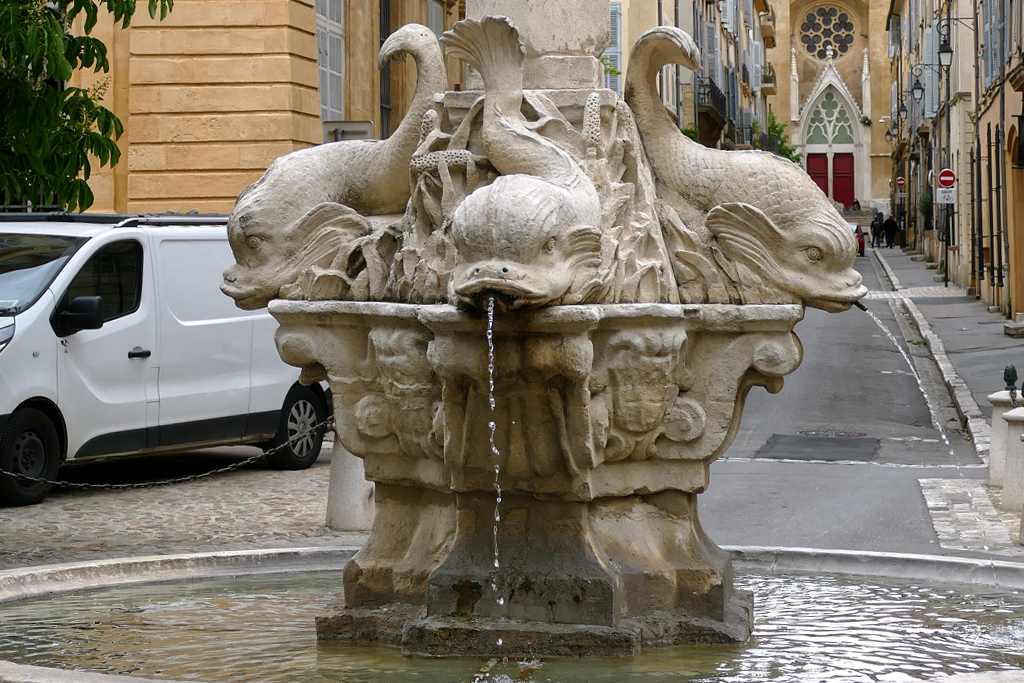
The fountain with the four dolphins, designed by Jean-Claude Rambot on what was previously the Place Mazarine in 1667, was so impressive that the square was renamed after it. The street crossing the square, however, retained the name Mazarine.
Listed as a historical monument in 1905, the fountain consists of a circular basin made of Sainte-Baume stone. In the middle is an obelisk carried by four dolphins. Their caudal fins are sculpted from Calissanne stone.
The top of the obelisk was first decorated with a golden lily, then with a pine cone, then with a Maltese cross, and finally yet another pine cone.
Fontaine de la Rotonde
The Rotunda at Place du Général de Gaulle reflects the past and future of Aix’s development. The square was built between 1840 and 1850 and has a diameter of 100 meters. Then, in 1860, a fountain was added in the middle according to plans by the engineers Tournadre and Sylvestre.
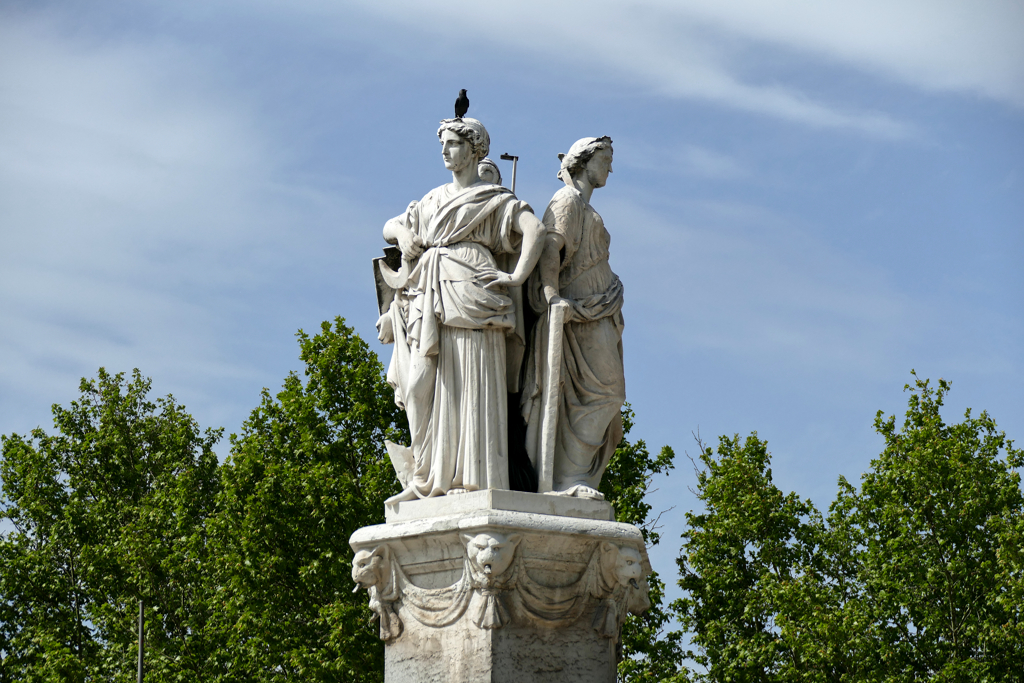
The 12-meter-high fountain is made of marble and has two basins. Local sculptor François Truphème decorated it with lions, dolphins, swans, and children.
The biggest eye-catchers, however, are the Three Graces on the top of a hexagonal base. These statues, around three meters high, were all created by different sculptors. Aixois Joseph Marius created the one looking towards the Cours Mirabeau and the Palace of Justice. She stands for righteousness, obviously. Louis-Félix Chabaud designed the statue that looks towards Marseille and symbolizes agriculture. Finally, the statue by Hippolyte Ferrat represents the fine arts. She looks towards Avignon.
Fontaine des Neuf Canons
In 1651, Laurent Vallon created the fountain of the nine canons where Rue Joseph-Cabassol crosses the Cours Mirabeau. It consists of two pools stacked on top of each other.

Thanks to its low height, the fountain served as a drinking trough for sheep that were driven from Arles all the way to the Alps.
The fountain was also one of the last of its kind to be used for domestic purposes. Since 1929, it has been classified as a historical monument.
Fontaine Moussue
I think the Fontaine Moussue is really a kind of miracle fountain. It’s actually called Fontaine d’Eau Chaude, hence, warm water fountain. And rightly so, because it is fed by a thermal spring, so its water remains at a constant temperature of 18° Celsius, regardless of the season!
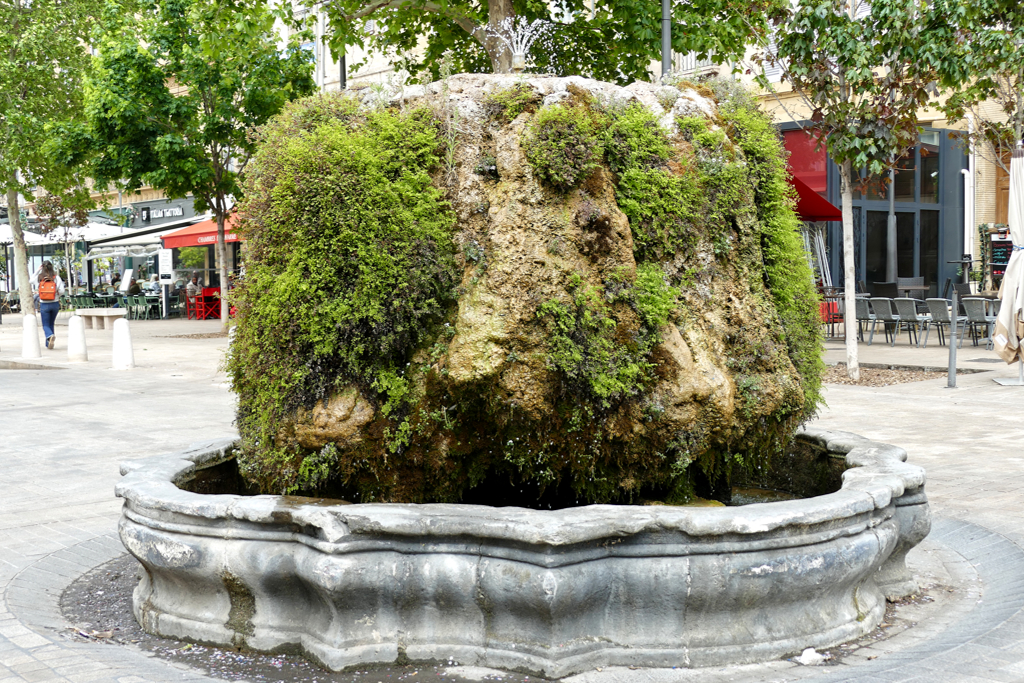
Architect Jacques Fossé designed the fountain in 1667. It was originally decorated with a Triton sculpture, but this was destroyed by some drunks. In 1670, a new design was created, including four angels holding a stone basin. This creation also could not be protected from vandals. In the end, only a cube-like block of stone remained.
Due to the consistently warm water temperature, mosses, ferns and algae proliferate and cover the fountain in fresh green all year round. However, these plants’ photosynthesis in turn leads to the precipitation of limestone travertine. As a matter of fact, it is this process that shapes the fountain.
The water emerges from a nozzle at the top as a small fountain and then runs over the block into the basin. In earlier times, housewives liked to draw the warm water from the basin for cleaning and doing laundry. The spring is not suitable for drinking water.
Fontaine Du Roi René
By the time you get to this fountain, you will have crossed the entire Cours Mirabeau.
The King René Fountain is located where the so-called pyramid fountain used to stand. It was destroyed during the French Revolution.
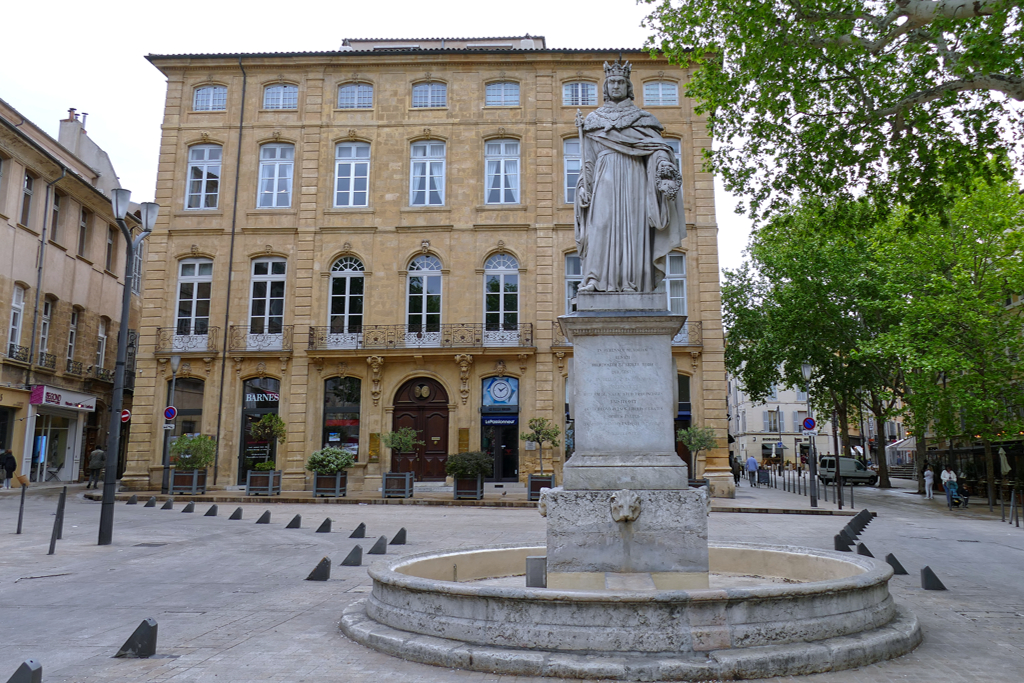
The lower part of the fountain consists of a round basin and a square base made from white marble. On the pedestal stands King René. Pierre Revoil and David d’Angers created it in 1822. René holds a scepter in his right hand and an umbel of grapes in his left.
The fountain has a total weight of 6.6 tons. It was made in Paris, and getting it to Aix took one month!
Roi René
René I d’Anjou was born in 1409 in the castle of Angers and died in Aix-en-Provence in 1480. He was the second son of Duke Louis II of Anjou and Jolanthe of Aragon and was also called René of Sicily, René of Naples, or Le Bon Roi René, hence, the Good King René.
You think that’s a bit exaggerated?
Then wait to hear his aristocratic titles: Imperial Prince of the Holy Roman Empire, Count of Guise, Duke of Bar, Margrave of Pont-à-Mousson, Duke of Lorraine, Count of Provence, Duke of Anjou, King of Naples, Titular King of Jerusalem, and Anti-King of Aragon.
In addition to his military activities, he devoted himself to the development of his possessions in the territories of Anjou, Lorraine, and Provence. The cities of Angers, Aix-en-Provence, Avignon, and Tarascon were particularly close to his heart.
Roi René maintained literary and scientific circles in both Aix and Angers. He dedicated himself to the revival of Old Provençal poetry by collecting the poetic works of the troubadours. However, he also wrote poetry himself. Interested in the arts, Roi René also tried his hand at painting. Nevertheless, many paintings in the style of the early Dutch painters were attributed to him simply because they bore his coat of arms. In reality, he was only the commissioner.
Fun Fact:
After René I. died in Aix in 1480, the people of Angers stole his remains to bury them in their city’s Cathedral.
Rue Fontaine d’Argent
Georges Vallon designed the Fontaine d’Argent in a Baroque style in 1758. Two chubby men wearing Ottoman turbans tirelessly spit water into the basin.
The upper part of the fountain contains a vessel where the city’s weapons were stored.

It was originally called the fountain of the black mule. Due to its proximity to the Jeu de Paume Theater and the Rue de l’Opéra, it was later renamed to the fountain of the comedy. Ultimately, the name Fontaine d’Argent, hence, Silver Fountain, stuck.
In 1949, the Fontaine d’Argent was classified as a historical monument.
Fontaine de Prêcheurs
The Place des Prêcheurs is in front of the Palais de Justice. It was built in the 15th century and was the center of public and social life before the Cours Mirabeau was constructed. It was named after the Dominican monastery near the square, which was later destroyed during the French Revolution.
Around 1640, Jean Lombard expanded and embellished the square. Today it is hard to imagine that the beautiful Preachers Square was once used for public shaming and executions. As a matter of fact, exactly where the royal gallows used to stand is now the Fontaine de Prêcheurs, which dates back to the Enlightenment era.
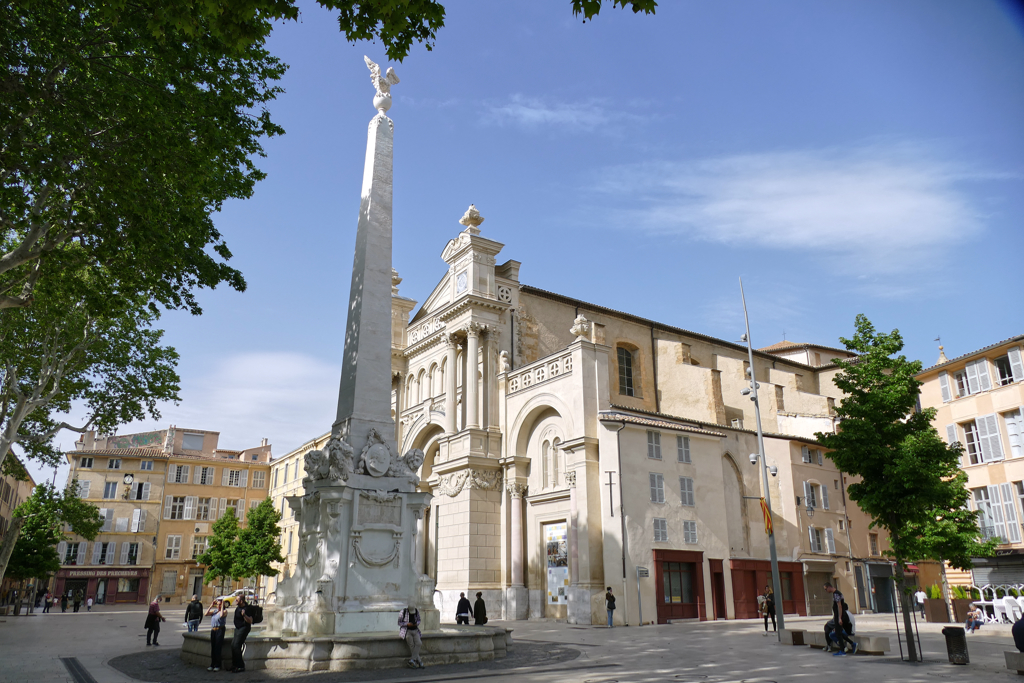
Jean-Pancrace Chastel built the fountain in 1748. Lions stand guard at four corners around a high obelisk while four sea gods spew water. The four medallions embedded in the obelisk show the founder of the Roman settlement Aquae Sextiae, Caius Sextius Calvinus, as well as the kings Charles III, Louis XV, and Louis XVIII.
On the northeast side of the square is the Église de la Madeleine. It is the former church of the destroyed Dominican monastery and was built by Laurent Vallon between 1691 and 1703. However, the facade was added between 1855 and 1860 according to a monumental design by Henri Révoil.
Aix’s most celebrated son Paul Cézanne was baptized here in 1839. His parents married in the church in 1844 as well as his sister Rose in 1881. However, Cézanne himself married Hortense Fiquet in the Eglise Saint-Jean-Baptiste du Faubourg in 1886.
Fontaine des Bagniers
The Bagniers Fountain – also known as the Chapeliers Fountain – is located opposite the Rue des Bagniers, after which it is named, in the throng of small shopping streets in the heart of the city. The fact that it was built in 1687 makes it one of the oldest fountains in the city, obviously. However, in 1758 it was moved a few meters because it was in the way of traffic. Father and son Vallons were commissioned to install it against a wall to make more space. This move cut the fountain from the hot water supply. It now flowed to the Mossy Fountain on Cours des Carrosses.

All that remains from the 17th century is the trough-shaped basin. Nevertheless, the heads and the base are from the 20th century and are based on the original models. Ambroise Vollard contributed a bronze medallion based on Renoir with a portrait of Cézanne. Since then, the fountain is also nicknamed the Cézanne Fountain.
It was listed as a historic monument in 1949.
Fontaine des Lumières
At first glance, the Fontaine des Lumières will certainly not impress everyone. The fountain is too unusual for that and may not be immediately recognizable as a work of art. I could imagine that many passers-by think it is a ruin. Jean-Michel Battesti designed it in 1998.
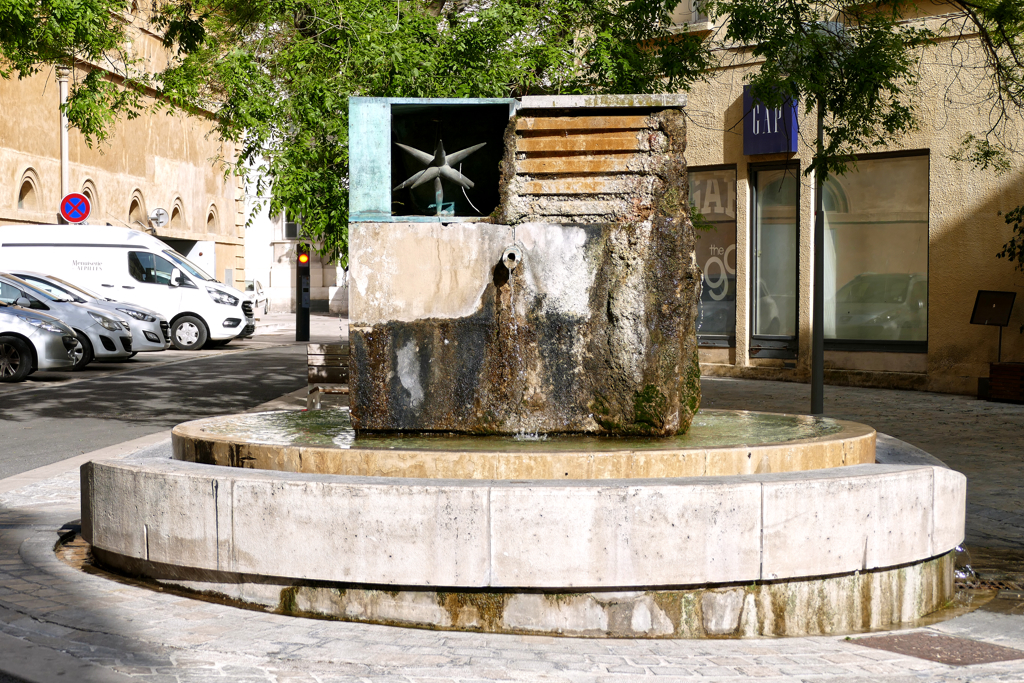
It is a cube made of stone and wood that stands over a round basin. A twelve-pointed star made of gilded bronze adorns a recess in the box.
Interestingly, the Fontaine des Lumières gets its warm water from the Bagniers spring. The fountain is located behind the Court of Appeal in a small square at the intersection of Rue des Chaudronniers and Rue Monclar.
Fontaine Sanglier
This fountain was initially exhibited in the town hall of Aix. It wasn’t until the 1980s that it was moved to Place Richelme.

Like the famous Porcellino, the Boar Fountain at the Mercato Nuovo in Florence, the Sanglier is a bronze interpretation of an Italian Renaissance marble sculpture by Pietro Tacca. It shows a wild boar with water flowing out of its snout. At the animal’s feet, snakes, turtles, and snails provide a naturalistic setting.
Fontaine de l’Hôtel de Ville
Fontaine de l’Hôtel de Ville was built in 1756. In the middle is a Roman column that comes from the ruins of the count’s palace. It stands on a pedestal above a water basin with four recessed sides designed by Georges Vallon. The water comes from the Pinchinats spring, which has been known since Roman antiquity. The Romans had built several aqueducts to supply water to the city of Aix-en-Provence.
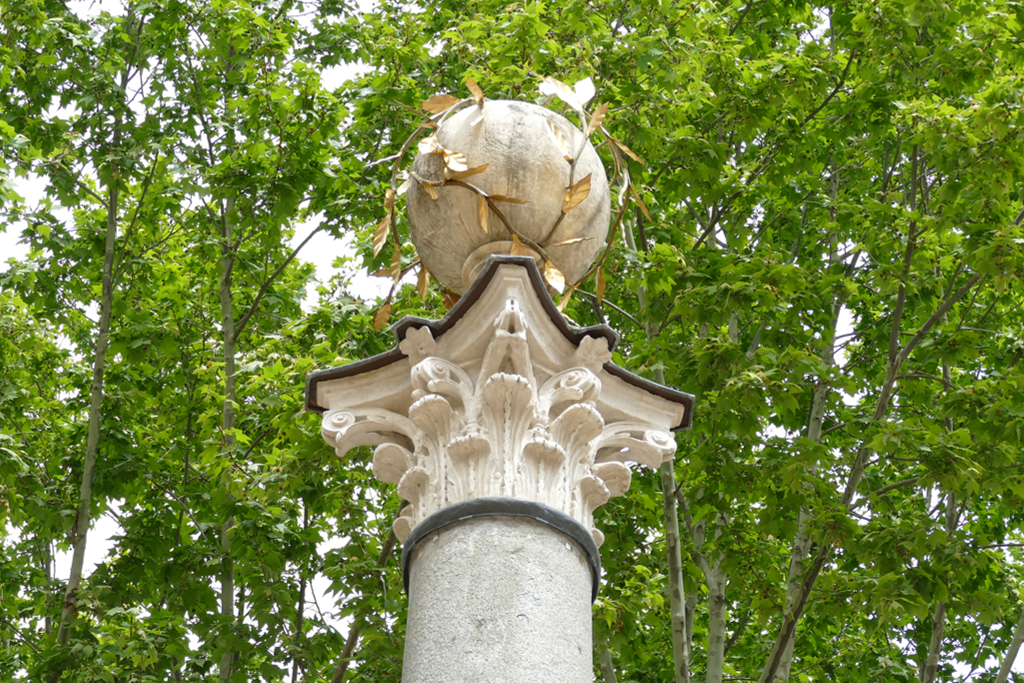
The fountain was listed as a historical monument in 1905 and was partially decorated by the famous Aix sculptor Jean-Pancrace Chastel.
In the middle of the fountain, there is a Roman column on a square marble base that comes from the ruins of a count’s palace. At the top of the column is a globe wrapped in golden leaves. Just like the Fontaine de Prêcheurs, sea god sculptures spew water into the basin.
During the revolution in 1789, the fountain served as a demarcation point according to which the city was divided into districts.
In addition to the magnificent fountain, there is a lot more around the Place de l’Hôtel de Ville Square to discover. But I’ll show you that below once we’ve gotten to know the most beautiful fountains.
Fontaine des Cardeurs
Just as the fountain is only one of the many great features of the Place de l’Hôtel de Ville, the Fontaine des Cardeurs is solely one of the many attractions that can be found around the Place des Cardeurs. By the way, we’re talking mainly about gastronomic attractions here, but I assume that shouldn’t really trouble anyone, am I right?
The Place des Cardeurs is behind the town hall. At the eastern end is the Cardeurs Fountain, also known as the Amado Fountain, named after its creator. From a distance, it looks a bit like the Fontaine Moussue.

In the middle of the very shallow basin is a sculpture designed by local sculptor Jean Amado. It is a massive block of earth-colored basalt cement into which more or less deep fissures were dug. Water flows through these deep grooves which wets the walls and, thus, promotes the growth of vegetation.
Do you want me to tell you a well-kept secret? The fountain also hides a cleverly hidden vent of the Cardeurs’ underground car park!
Fontaine des Tanneurs
And we continue to Place des Tanneurs, another cozy square where the surrounding bars have set up tables and chairs so that locals and visitors can relax and idle. In the middle, how could it be otherwise in Aix, there is a pretty fountain. Incredibly, the space is located at the intersection of six streets, yet still has the feel of a hidden backyard.
Where the Place des Tanneurs is today, the old city wall stood until the beginning of the 17th century. More than two centuries ago, artisan tanners settled in this district and gave their names to the square and the surrounding streets.
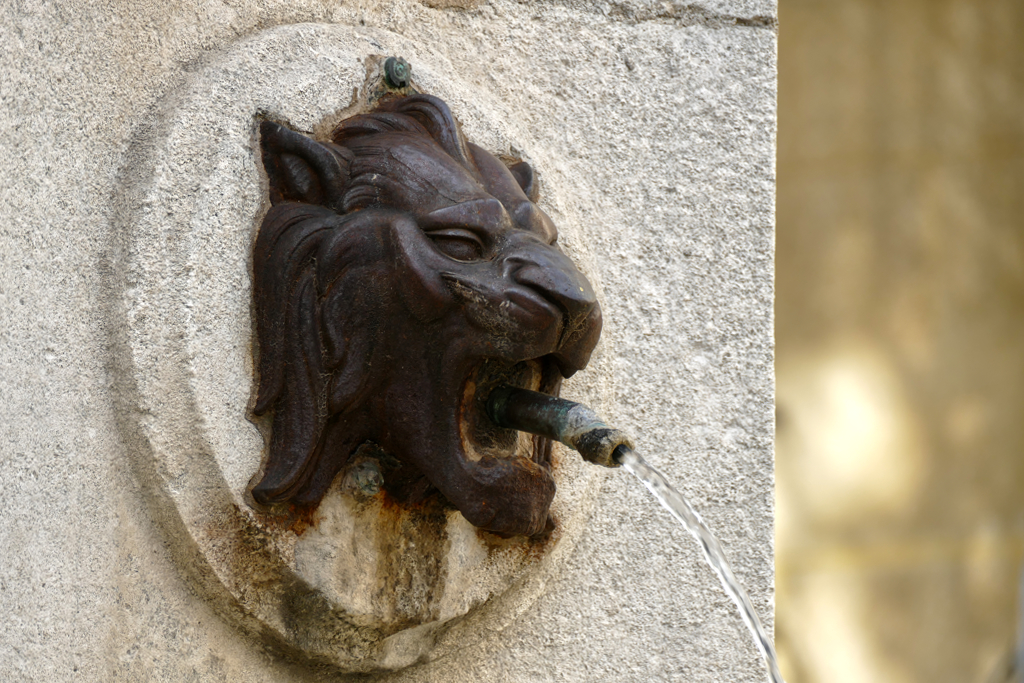
This fountain was also built according to the plans of Georges Vallon in 1761 and operated with water from the town hall fountain.
Aquatic plants blocked the pipes so that the fountain remained inactive for around fifty years. In 1861, the city decided to repair the supply lines and rehabilitate the fountain.
Fontaine Séraphin Gilly
My absolute favorite place is a very small and unknown square which makes it particularly charming.
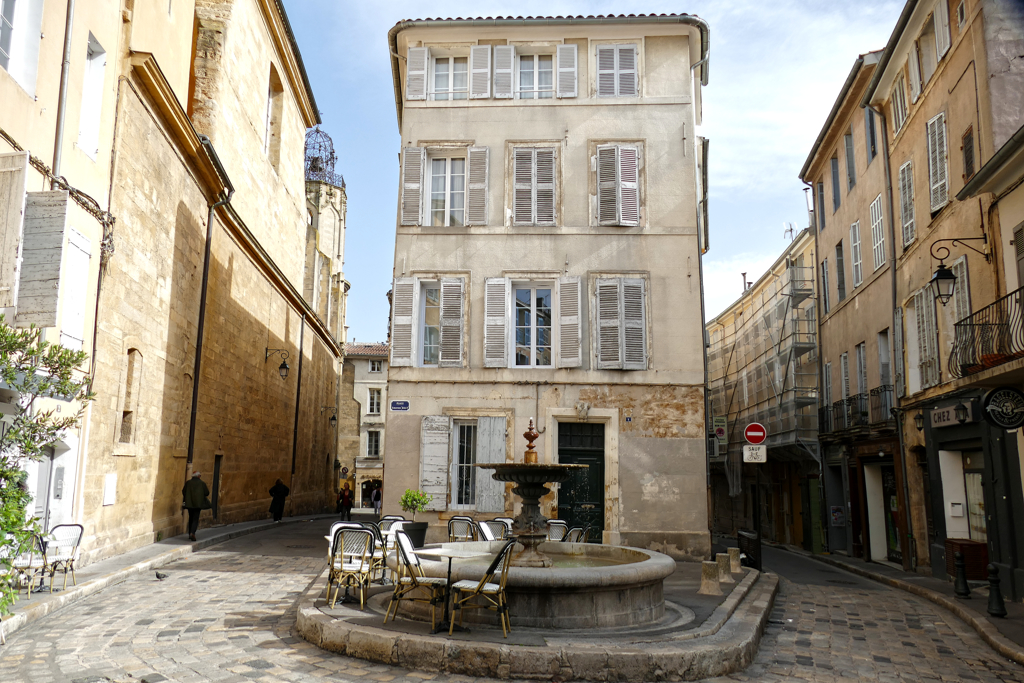
Between the Église du Saint-Esprit and the Place des Tanneurs, another fountain was added in 1988. It was named in honor of the sculptor Séraphin Gilly. Gilly made a name for himself by renovating historical monuments such as the Paris Opera and the Arc de Triomphe. He also created hundreds of busts made of wood, marble, bronze, and in the form of bas-reliefs. Some of them decorate various places and buildings in Aix such as the law school.
Fontaine Des Augustins
Really, at some point, I gave up counting squares surrounded by cozy terraces where you can enjoy an Apéritif while a pretty fountain ripples in the center. There are just too many!
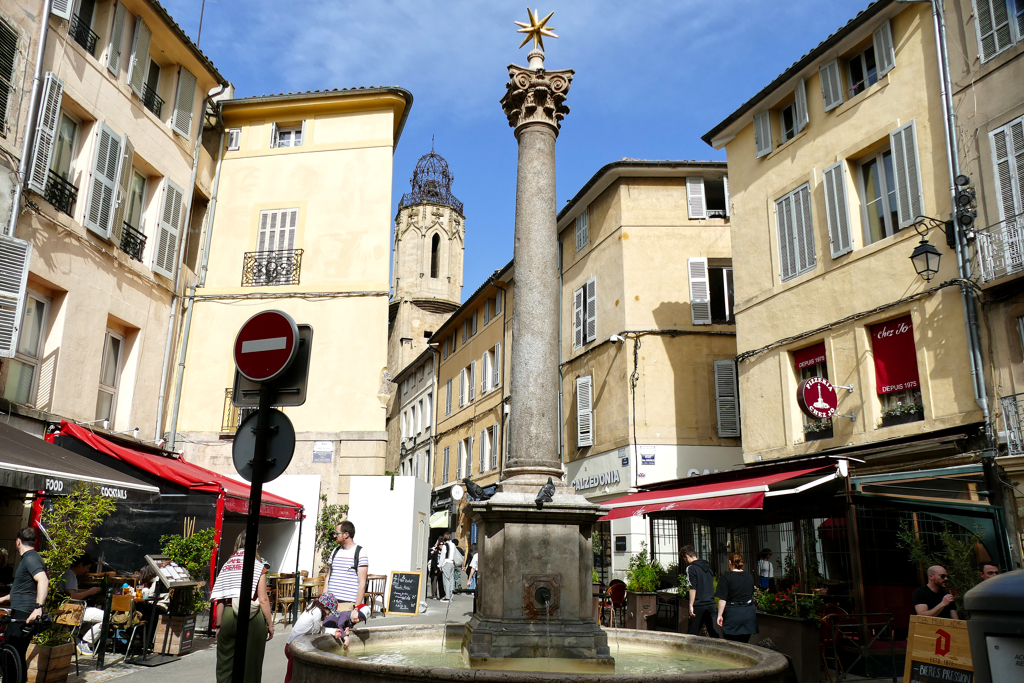
In addition to all the highly popular squares, the Place des Augustins is somewhat overlooked. Many people simply scurry through without paying attention to the beautiful Fontaine Des Augustins which dates back to 1620. In its current form, however, it was erected only in 1820. At that time, it was decorated with a Roman column from the count’s palace on the site of today’s courthouse. At the top of this pillar is a twelve-pointed copper star. The base of the fountain is made of Peynier stone.
The water from the fountain was used for a long time to fill the station reservoir which powered the Alpine railway in the era of steam locomotives.
The fountain has been listed as a historic monument since 1949.
Fontaine Villeverte
Because this fountain is not located directly in the historic center of Aix, it is often overlooked. Quite wrongly, because the Villeverte fountain on Place Paul Ferreol is a reminder that this district of Aix-en-Provence was once surrounded by numerous meadows and fields.
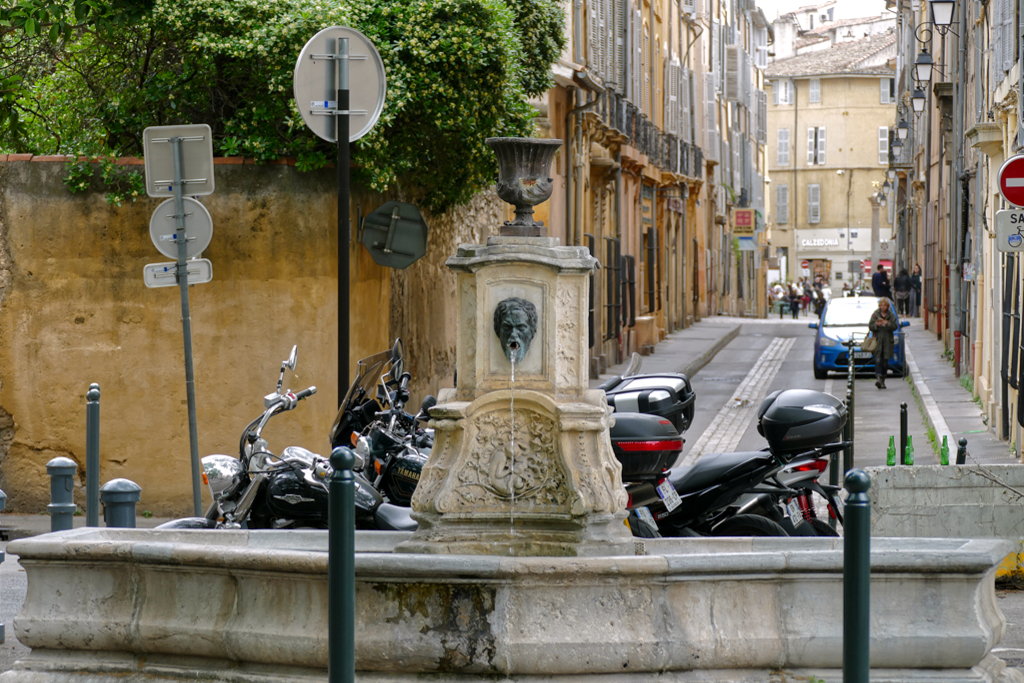
The fountain is fed by the spring under the Molle crossing and dates back to 1683. To this day, it has two pools. The wide basin with a low edge was used for livestock. The other is shaped like a shell, which made it easier for the residents to draw water from it.
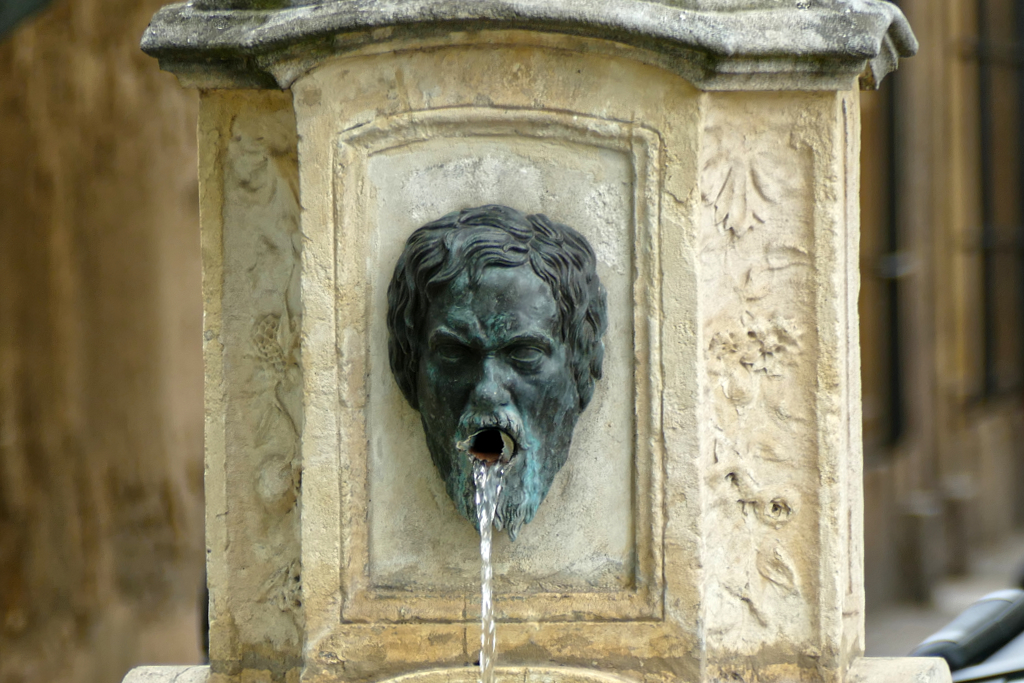
The basin and shell are each fed by a bronze mask depicting the head of a stern-looking man with water spouting from his open mouth. At the top is a cast iron urn placed there in 1848.
Fontaine des Minimes
This fountain is one of the oldest and historically most important ones in Aix. Since the beginning of the 15th century, it belonged to the archiepiscopate and was then called Sainte Croix. Located on the corner of the Cours des Minimes and Avenue Maréchal de Lattre de Tassigny, it became the city’s property in 1680. From then on, the Minimes friars irrigated their riverside gardens with the water from this austere fountain.
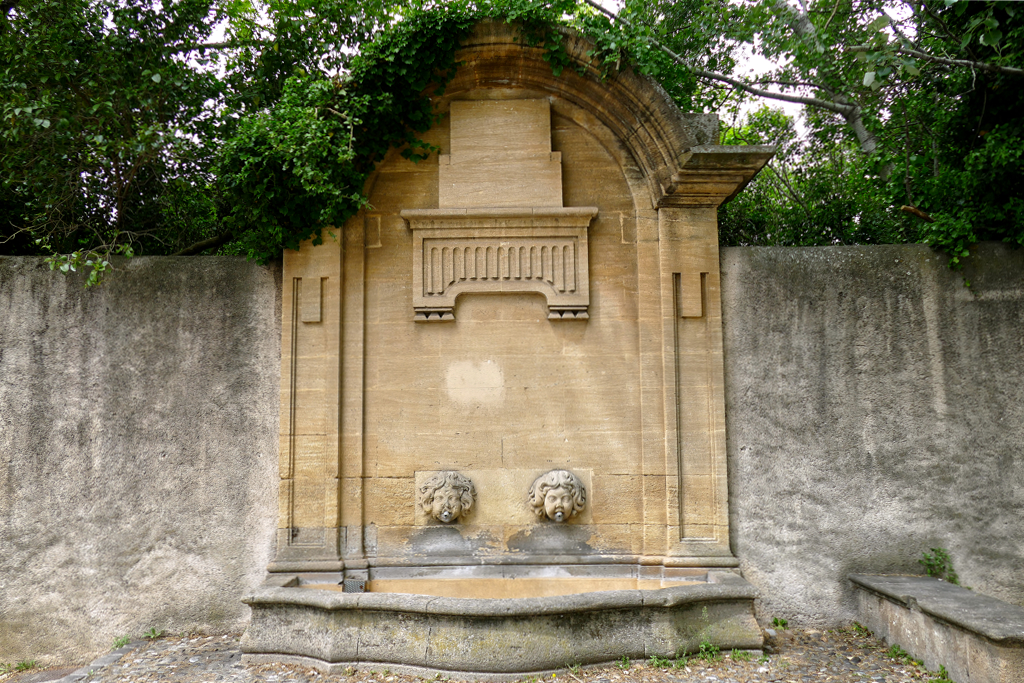
The design of the Fontaine des Minimes is rather unadorned. It has a large frame rimming two slabs of softer stone. The water spills through two spouts, running out of human mouths.
Once you are at the Fontaine des Minimes, walk up the Avenue Maréchal de Lattre de Tassigny and then turn right into Rue de la Molle. Here, at number 13 is the stately Pavillon de Vendôme.
Also called Pavillon La Molle, this mansion is the most important of the numerous baroque aristocratic palaces in Aix-en-Provence. Louis de Vendômes commissioned it in 1664 for Lucrèce de Forbin-Solliès, called The Beauty of Canet. Eventually, it was redesigned and expanded various times by the subsequent owner.
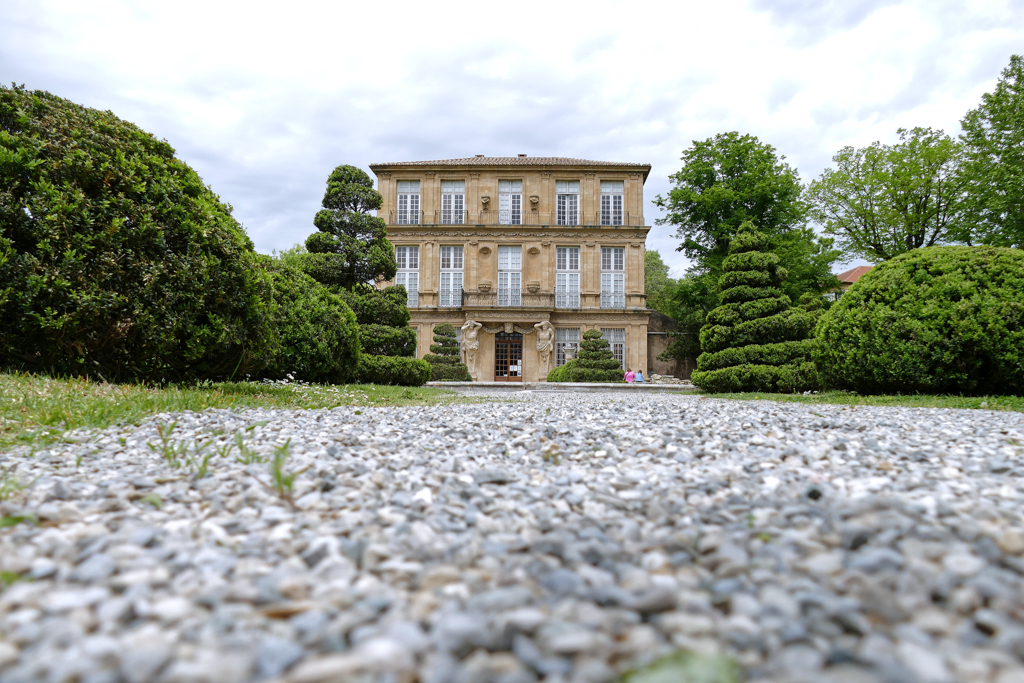
After having been used by an order of nuns in the 19th century, it was then owned by the Swiss art collector Henri Dobler from 1906 onwards. Dobler bequeathed the villa and its works of art to the city of Aix. Today, the building houses a small museum displaying Provençal furniture and portrait paintings from the 17th and 18th centuries. It is open to the public from Wednesday to Monday between 10 a.m. and 12.30 p.m. and then again in the afternoon from 1.30 p.m. to 6 p.m., albeit, hours can differ according to the season.
Aix’s Most Inviting Squares
So there are all those amazing wells’n’fountains, and apart from water, they need space. Luckily, Aix-en-Provence has secured many beautiful spots for its impressive fountains. These can be intimate, sweet corners, but also spacious, stately courts.
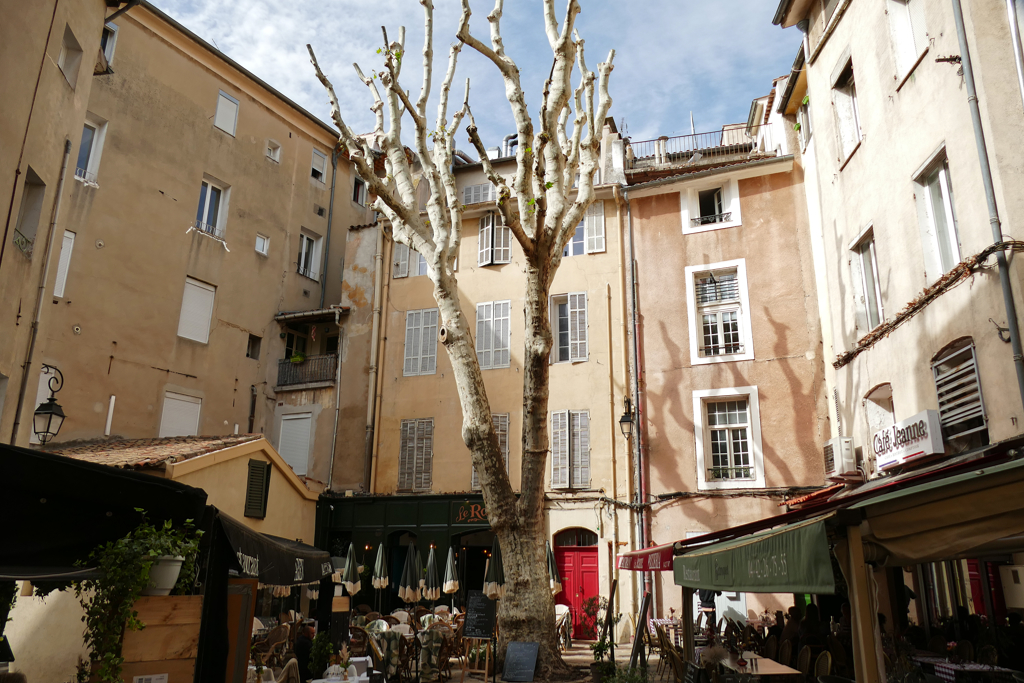
I have already introduced many of the small, picturesque, and sometimes a bit hidden nooks and crannies in the section above. In this chapter, I dedicate myself to four of the largest and most impressive squares that you should definitely see when visiting Aix.
Place de l’Hotel de Ville
Aix’s town hall square Place de l’Hôtel de Ville is probably one of the most famous squares in Provence. The current town hall was built in 1678 and is a replica of the original building from the 14th century. Pierre Pavillon – with that name, he could only become an architect! – built it with the support of the sculptors Jean-Claude Rambot and Jacques Fosse. The new building is directly connected to the famous bell tower. During the French Revolution of 1789, the ornaments and some sculptures such as the bust of the Count of Provence were destroyed.
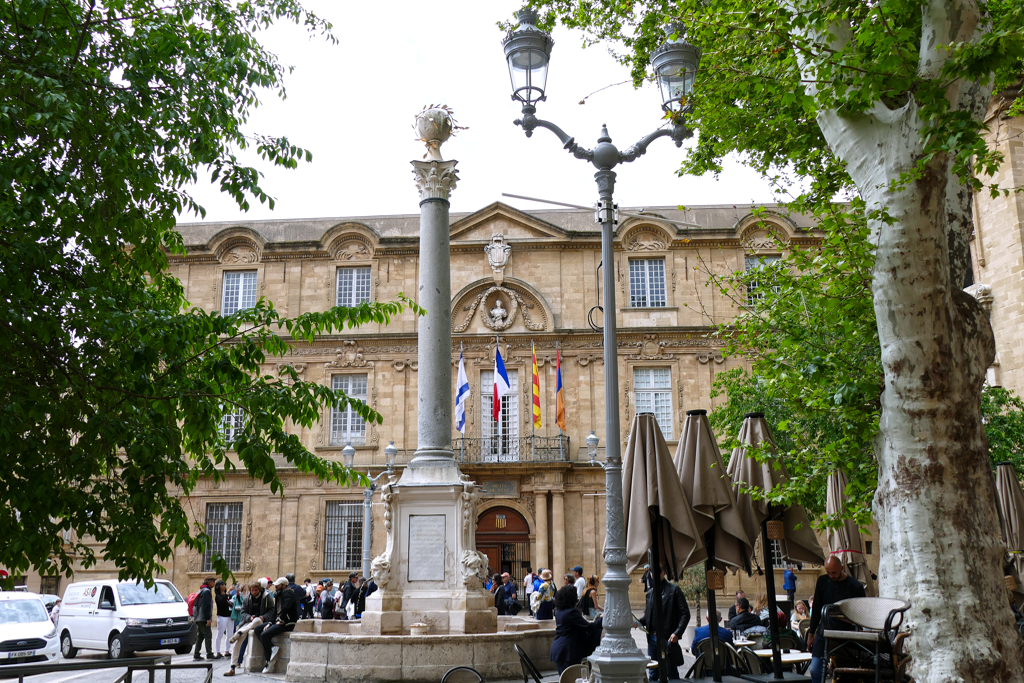
Until the Cité du Livre was opened, the Bibliothèque Méjanes, one of the most important collections in France, was housed on the ground floor.
To the north of the square is the unique bell tower, built in 1510. It is particularly famous for its astronomical clock from 1661. Above it is a medieval bell in some kind of a cage, the so-called cloche du ban. In the Middle Ages, the ban was the power to draft men into military service.
The 18th-century Corn Exchange Hall is located on the southern edge of the square between Town Hall Square and Richelme Square. The artfully decorated former grain exchange building now houses the city library and post office.

It wouldn’t be a French square if it wasn’t lined with cafes and restaurants with lovely terraces. There is a flower market on the square from 8:30 a.m. to 1 p.m. on Tuesdays, Thursdays, and Saturdays. There is also a great book market on the first Sunday of every month.
Place des Tanneurs
The tannery trade was formerly very considerable in Aix. There are several very honorable families who made their fortune there and have since held important positions in the local government.
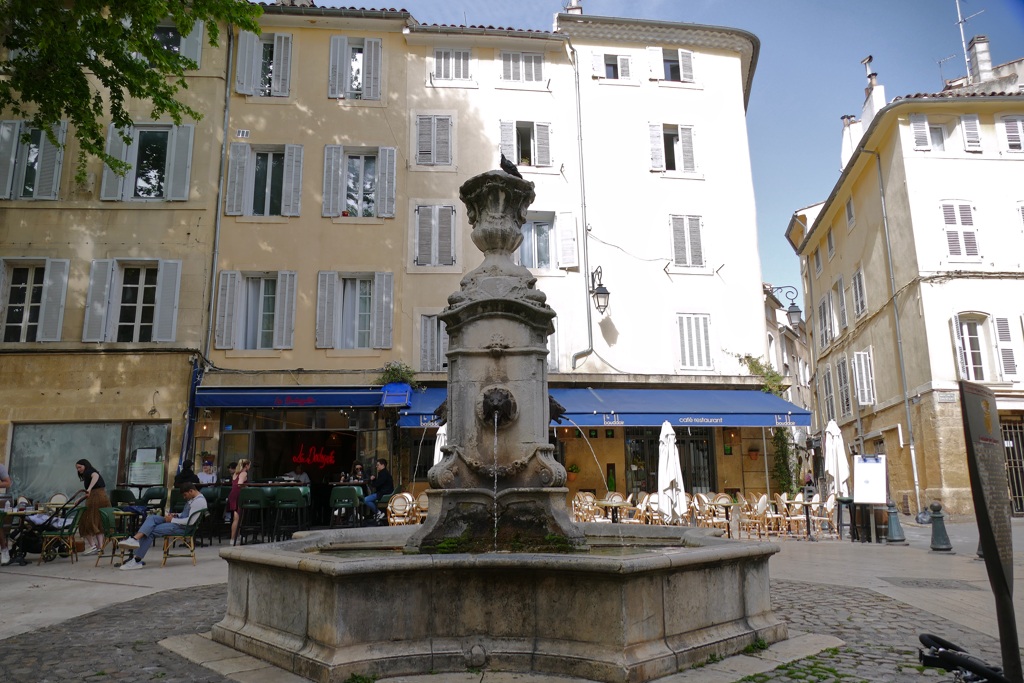
Although the square is located at the intersection of six streets and alleys, it is not very large and, above all, pleasantly quiet. There are a few upscale cafes and restaurants with lovely outdoor terraces where you can sit and people-watch all afternoon while enjoying a delicious refreshment.
Place des Cardeurs
The Place des Cardeurs is located in the center of the city right behind the town hall. It stands on the site of the former Jewish quarter from the Middle Ages. Today’s square, however, was constructed only in 1963 following the demolition of a block of unsanitary houses.

The vacant space served for a long time as a parking lot. Then, in the 1980s, an underground car park was constructed below the square. I’ve mentioned it above as I introduced the peculiar fountain designed by Jean Amado. Eventually, an overwhelming number of restaurants were set up, transforming the square basically into a posh outdoor food court. Especially during Aix’s mild summer nights, the Place des Cardeurs hustles and bustles like a human beehive and has a very special atmosphere.
Place Richelme
One of the largest and most magnificent squares in Aix-en-Provence is Place Richelme. It is a fantastically beautiful place, surrounded by stately buildings with high golden facades. Tall plane trees give the square a special flair and of course provide much-needed shade, especially in summer.
Place Richelme seems to have two quite distinct personalities, a bit of Doctor Farmers Market and Mister Aperitif Bar. It is fascinating how different the ambiance of the square is during the day and at night.
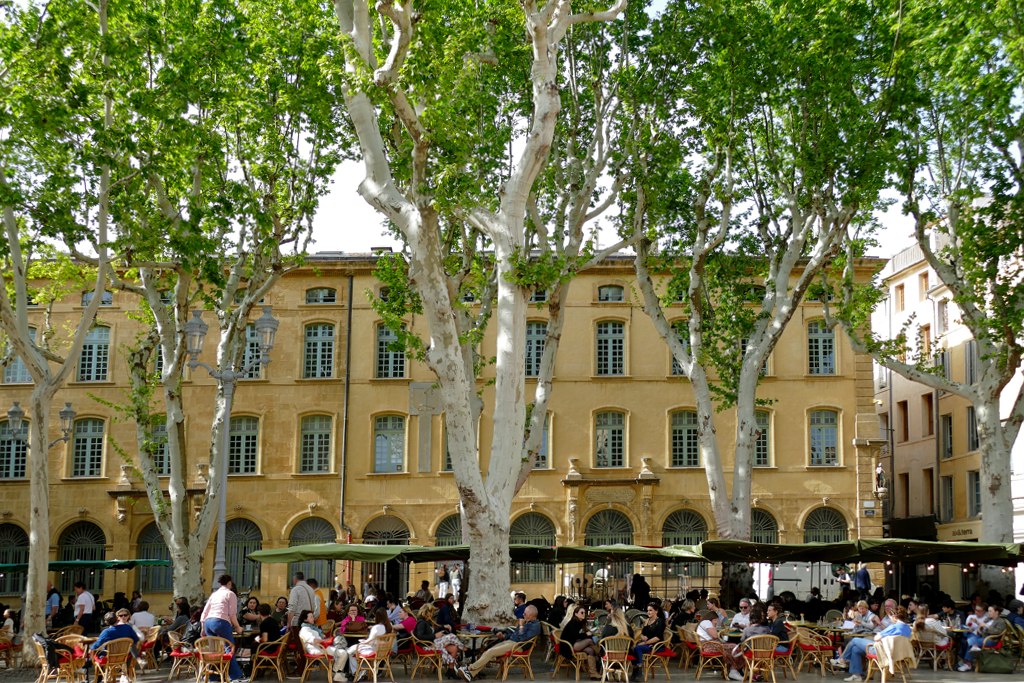
The daily market is one of Aix’s most popular food sources. Although it is one of the city’s most colorful attractions, it has retained its authentic flair. This is where locals shop, as they have done for centuries. On the small side square, Places aux Herbes, are the stalls where fish have been sold for 500 years. This oldest square in Aix is often named Place de Sanglier after the giant bronze boar. I had already introduced the fountain of the same name above.

So take a seat on one of the terraces, order a coffee, and enjoy the wide mix of Aix’s population. Relish the colors, smells, and sounds that come together in a captivating extravaganza.
In the evening, the market stalls are dismantled and Place Richelme becomes an elegant court where locals meet for an aperitif or a casual dinner al fresco.
What Else Aix Has to Offer
I think I’ve already put together a pretty extensive program for you that could easily fill a day in Aix. Suppose you have more time or are unfortunately not in the city on one of its over 300 sunny days. In that case, there are of course also indoor activities such as visiting churches or seeing exhibitions in the city’s beautiful museums.
I would particularly like to highlight the Musée Granet art museum, which is one of the oldest and most extensive in all of France.
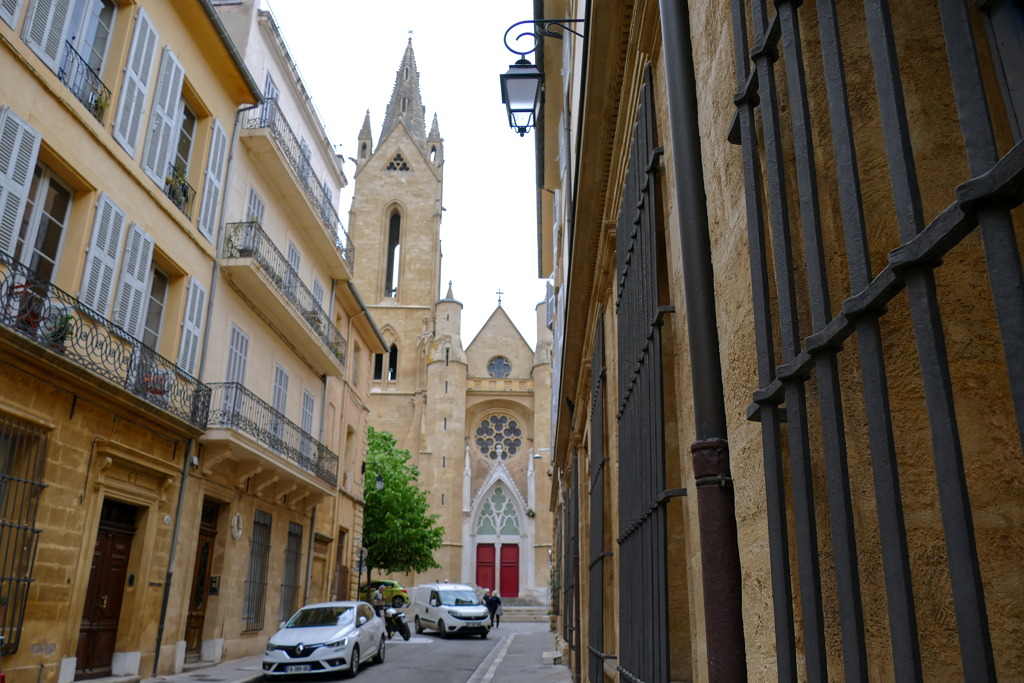
It was established in 1765 with the foundation of the antique collection of Fauris de Saint-Vincent. In 1849, the local artist François Marius Granet bequeathed all the works of art in his possession to his hometown of Aix. Several foundations added works to the collection. Since the 19th century, the museum has been housed in an Order of Malta priory, built in 1671 on the site of the Saint-Jean-de-Malte church in the Mazarin district.
The Musée Granet is open from Tuesday to Sunday between noon and 6 p.m. for a general admission fee of 6 €uro.
Fun fact:
It was not until 1984 that eight paintings by Paul Cézanne arrived on permanent loan from Paris at the Musée Granet. Until then, the painter’s birthplace could not boast a single one of his paintings!
Another real treasure trove is the elegant Hôtel de Caumont just off the Cours Mirabeau.
It is a former aristocratic palace in the classicist Baroque style. François Rolland de Réauville de Tertulle, the Marquis of Cabannes, commissioned the architects Robert de Cotte and Georges Vallon to build it. It was completed in 1742.
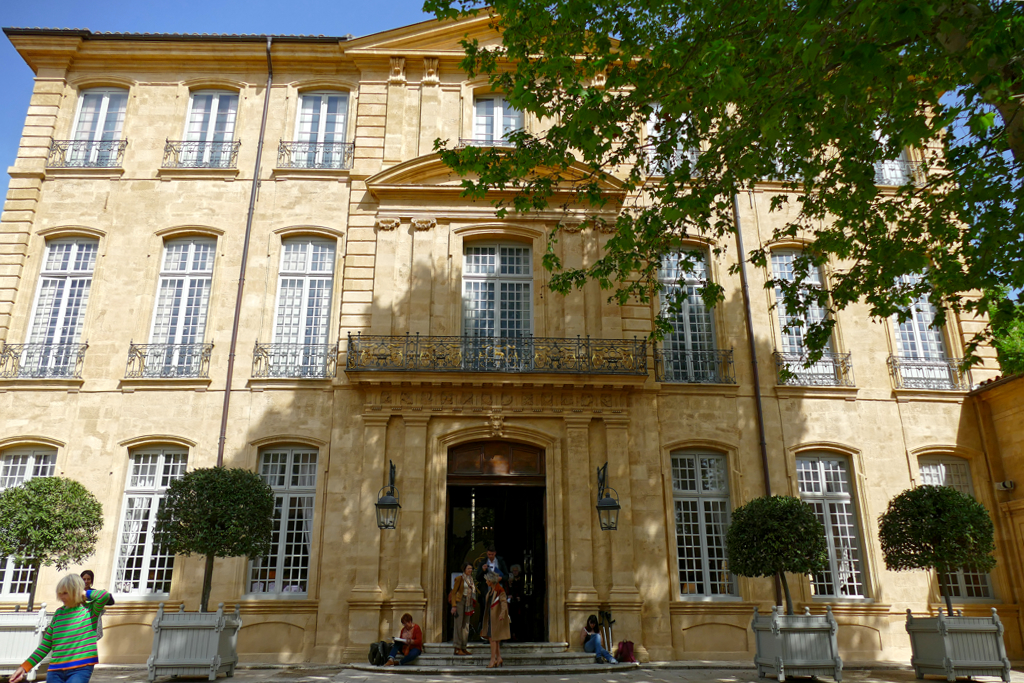
After several owners, it came to the Marquis Amable-Victor-Joseph-François de Paule de Seytres de Caumont through marriage in 1796. In 1964 the last descendant sold it to the city of Aix. After various uses, it was acquired by the Culturespaces institution in 2013, restored, and opened as an exhibition and event venue in 2015.
The Hôtel de Caumont is open every day from 10 a.m. to 7 p.m. and the entrance fee is 6.50 €uro when there is no temporary exhibition. Otherwise, it’s 15.50 €uro.
An unexpected venue among Aix’s art galleries is certainly the Fondation Vasarely Museum. Victor Vasarely was born Gyözö Vásárhelyi in Hungary in 1906, after all. However, he lived much of his life in France and actually designed a museum building on the outskirts of Aix that now houses dozens of his monumental works.
The gallery is located in the southwest outside of the city, but you can get there quickly and easily by bus.
The Fondation Vasarely is open from Wednesday to Sunday between 10.30 a.m. and 5.30 p.m. for a general admission fee of 15 €uro.
Practical Information
How to Get There
By Plane
You can easily reach Aix-en-Provence by plane if you land at the Marseille-Provence Airport. It is located about 30 kilometers southwest of the city in the municipality of Marignane.

From the airport, take the shuttle bus, the so-called Navette, to the bus terminal in the center of Aix-en-Provence. The bus goes every half an hour, takes about 40 minutes, and a single trip costs 10 €uro. A roundtrip will set you back 16 €uro. You can make a reservation online.
By Train
Like other cities in France, Aix-en-Provence has two different train stations. One is for the regional trains and the other one for the TGV high-speed trains. As a matter of fact, the TGV connects Aix-en-Provence to the entire country as well as other European cities such as Amsterdam, Brussels, Geneva, and Milan. Also, going from London to Lille by Eurostar and then by TGV to Aix-en-Provence is easily done in a day.
The Gare TGV is located approximately 15 kilometers southwest of the city. From Aix’s bus terminal, you can take bus L-40 to the station. A single trip sets you back 6 €uro while a roundtrip cost 9.60 €uro. By the way, it’s the same bus that then continues to the Marseille-Provence Airport, just so you know.
From the train station just on the outskirts of the very city center, direct connections are basically only within the region.
Especially the high-speed train TGV is a great alternative if you don’t want to fly. When travelling within the Provence region, however, taking a long-distance bus is the better option most of the time. Either way, you can get information and book tickets online on the website of the national train company SNCF – even for some long-distance buses!
By Bus
As I said above, taking a long-distance bus instead of the train might be a far better option when travelling within the Provence region. There are excellent bus connections between Aix and Avignon and Marseille as well as the cities along the Cote d’Azur such as Nice and Cannes. However, there are even direct buses to Paris. The ride takes about nine hours, and tickets start at 40 €uros.
The bus terminal, in French Gare Routière, is just outside the city center.
How to Get Around
You can easily get around the city on foot, but you can also take a bike. However, keep in mind that some parts of the city can be a bit hilly.

Aix has a comprehensive net of public buses, and tickets are quite cheap: For 1.20 €uro, you can travel for one hour as much as you please! You can even buy a pass with ten trips for as little as 9 €uros. Popular routes are served every 10 to 15 minutes. However, on Sundays and holidays, the service is significantly limited, obviously.
If you speak some French, you can check your route and connections on the site Aix en Bus. Otherwise, just use Google Maps. The App even informs you when the bus is late.
Where to Stay
One of the great advantages of French centralism is that also those totally preposterous prices stay in the capital. As soon as you leave Paris, things get significantly cheaper and this applies to accommodation, too.
Especially when you are in Aix-en-Provence only for one or two days, you might want to stay in a centrally located hotel so you can explore all the wonders the city has to offer by walking.
Booking.comI came to Aix by bus from Avignon, hence, I was more than happy to have stayed at the Hôtel Rotonde* just a stone’s throw from the main bus terminal. Not only is the hotel centrally located, but it is also in the heart of the city’s most alluring area and just steps from the most beautiful of Aix’s 130 fountains.
I assure you that after a good night’s sleep and a nice breakfast from their buffet, you’ll feel reinvigorated, and you’ll be ready to go all day.
In case they are booked out or if you simply prefer a different kind of accommodation, you can choose suitable lodging options in Aix-en-Provence on this map*:
What to Eat
French cuisine is famous all over the world for a reason. In fact, food is an important part of daily life in France and regional cuisines and customs are a cherished part of the national culture. UNESCO recognized France’s efforts and designated the country’s national cuisine as an intangible cultural heritage in 2010.
French cuisine is famous for its sophistication and versatility and, most importantly, the high quality of the ingredients used. Of course, each region has its own specialties, but they are often popular throughout the country. The most famous dishes come from Normandy, Brittany, Burgundy, and the Provence region, obviously.
In addition to delicious wine and crispy baked goods, more than 700 types of cheese are particularly noteworthy! In fact, the French don’t just slap cheese on a sandwich. They also use it a lot for cooking, gratinating, or as a filling.
Unfortunately, food in France is not cheap. Delicious snacks at reasonable prices are often available in bakeries and rotisseries as well as in eateries at farmers’ markets and in covered market halls. In general, lunch menus and daily specials, so-called plat du jour, are comparatively reasonably priced.
What’s Special?
Calisson, a mixture of candied almonds and melons with the scent of orange blossom, is the city’s great specialty. Calissons, which, as Provençal tradition dictates, are blessed each year in September, before a large distribution on the main artery, the Cours Mirabeau.

Cash, Cards, and Deals
Since 2001, 20 European countries have paid with €uros, and France is one of them, obviously. The exchange rate is 1 US$ = 0,93 EUR as of June 2024, but you can check the conversion on this page.
Also, you can pay with credit cards basically everywhere.
Although Aix-en-Provence is not the country’s most expensive city, if you want to visit some of the amazing museums, it quickly adds up. Also, you can join three themed guided walking tours in English and an incredible 15 tours in French free of charge with the Aix-en-Provence City Pass.

Especially if you are visiting with kids, the included Cezanne-themed treasure hunt is a truly unique activity. Obviously, it includes the use of public transport, too.
The pass comes in three versions and can also be comfortably ordered online*:
| 24 hours | 48 hours | 72 hours |
| 29 €uros | 39 €uros | 49 €uros |
Visiting Organized
Although I’m an avid solo-travelling woman, I sometimes like to join organized tours. This way, I get extended info about a place and it’s fun to visit landmarks in the company of like-minded fellow travellers.
Especially in summer when the lavender is in full bloom, Aix-en-Provence can get quite busy. Therefore, booking tickets’n’tour ahead is certainly a good idea*:
Connection and Communication
Since June 2017, no roaming charges have applied within the EU with a European mobile phone contract, This applies in all 27 countries of the European Union as well as in Iceland, Liechtenstein, and Norway and to all contracts.
In case European roaming is unavailable, you can connect to the internet without any issue at basically every museum, eatery, café, and, of course, hotel.
If you insist on being online 24/7, you can get a SIM card, obviously. Many companies supply prepaid SIM cards. 2.99 €uros, Orange France supplies the cheapest one. Other brands are SFR France, Bouygues Telecom, and Free Mobile. They cost 10 €uros. Keep in mind that some companies might also charge an activation fee.
In France, they use plug types C and E. Their voltage is 230 V and the frequency 50 Hz. Whereby, as nowadays, all these chargers have integrated adapters, in general, the voltage and frequency don’t really matter.
By the way, you’ll find this information and many more comprehensive travel tips in my post World’s Most Complete Travel Information – an indispensable globetrotter-classic.
Language
The French are famous for many great things. Presumably, speaking foreign languages is not one of those. While in über-touristy Paris, things seem to get a bit better, in the Provence region, people have rudimentary knowledge of English at most. And while they still might understand more or less what you are saying, they might not be able or willing to answer in English. Therefore, already out of respect, it won’t hurt to learn at least some polite phrases with the help of babbel or Lingohut, for example.
Map
This map should help you to find all the wonderful places I’m introducing in this post. Clicking on the slider symbol at the top left or the full-screen icon at the top right will display the whole map including the legend:
Aix-en-Provence was only one of five amazing cities I visited during my circle trip through the Provence. To read about the others, go to the post France – An Easy Circle Trip to the Five Best Cities to Visit in Provence and take your pick! There, you’ll also find further valuable general information that will make your own trip much smoother and more enjoyable.
Pinnable Pictures
If you choose to pin this post for later, please use one of these pictures:



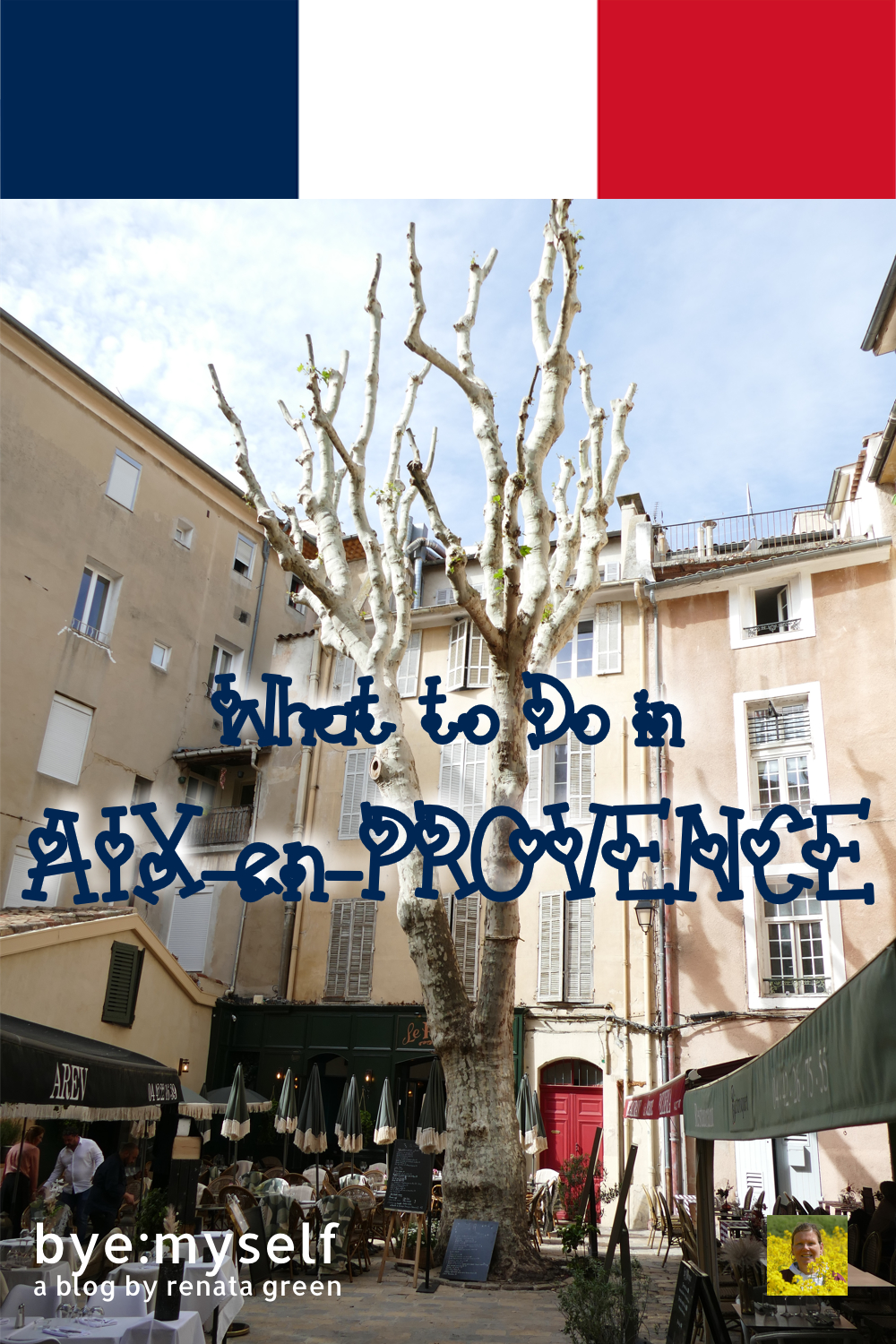

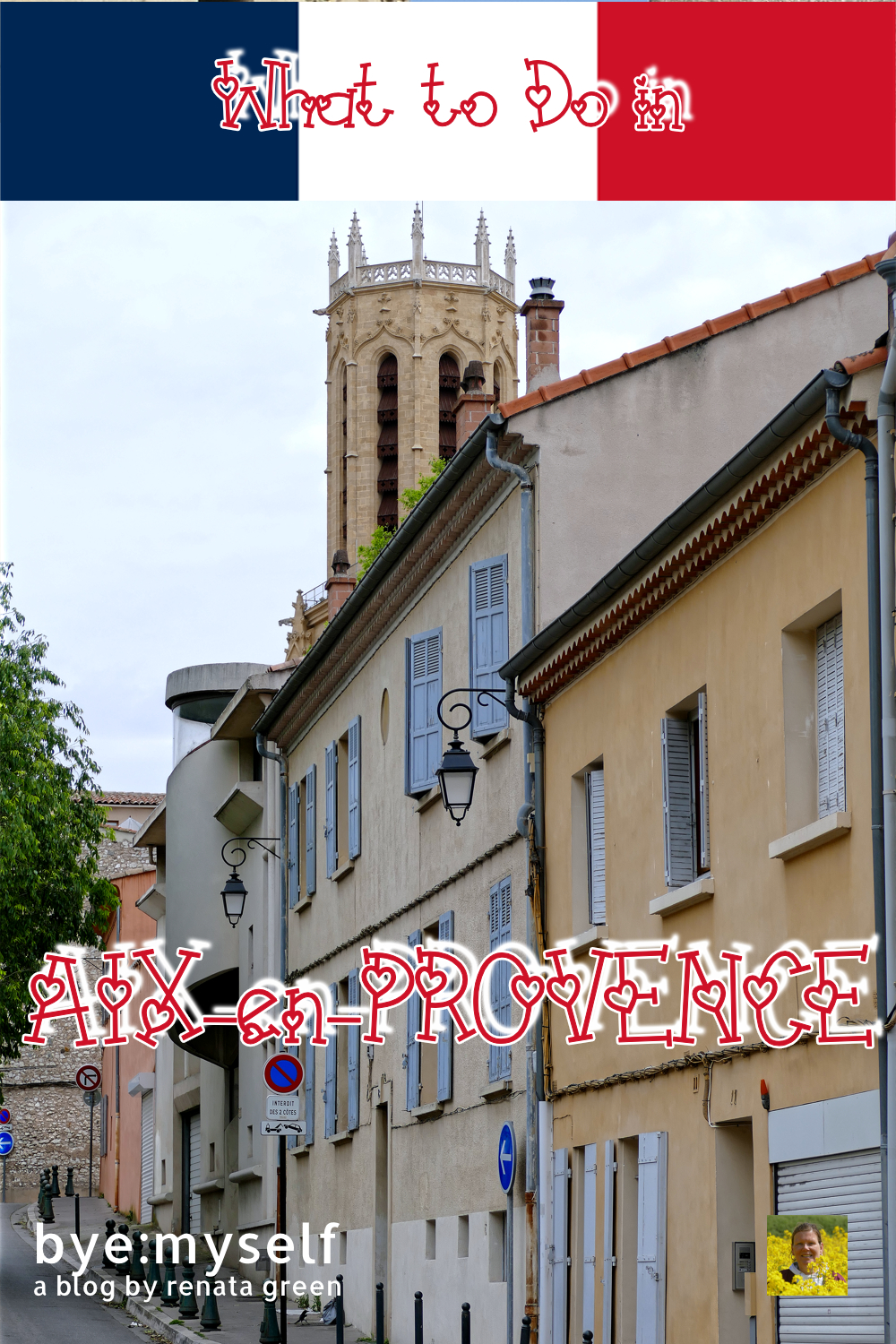
Did You Enjoy This Post? Then You Might Like Also These:
Best Places to Visit in Grand Terre, the Eastern Wing of GUADELOUPE (also by public bus)
GRAND GUADELOUPE: Complete Guide And Perfect Itineraries (also for travels by public bus)
Best Street Art in PARIS: How Mehdi Ben Cheikh Transformed the 13th Arrondissement Into An Open-Air Gallery
Pickled: Easy Recipes to Store the Mediterranean Sun in Your Pantry
MAGNIFICENT MARTINIQUE: Ten Places Not to Miss on Your Visit (even when exploring by public bus)
Cheesy Flight: Never Put Cream Cheese In Your Hand Luggage
One Day in ARLES – What Not to Miss in Vincent’s Picture-Perfect City
24 hours in PARIS
* This is an affiliate link. Hence, If you book through this page, not only do you get the best deal. I also get a small commission that helps me run this blog. Thank you so much for supporting me!
Disclaimer: The Aix-en-Provence Tourist Office supported my blogger trip by supplying me with information, an Aix-en-Provence City Pass, as well as accommodation.
However, all opinions on these services are mine and weren’t by any means influenced by my cooperation partner.






